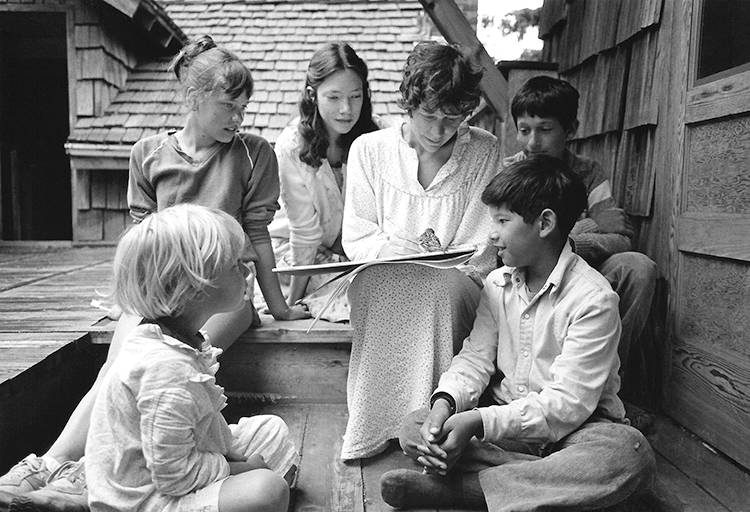My winter garden is quiet and lovely, with snow piled onto the shrubs and outlining the trees. For me, this is a time for resting and reflection, reading, drawing, and planning next year’s garden. Gardening has always been a part of my life. As a child, I spent summers playing in my grandfather’s stately and formal garden in Rochester, New York, where my great grandfather had managed the Ellwanger and Barry Nursery. Composed of a staggering 650 acres, this was the largest nursery in North America at the time.

I grew up and studied in Berkeley, California, then in 1965 married and moved to a mountain sheep farm in northern British Columbia. We were almost self-sufficient and our vegetable garden was gigantic. With virgin soil and heaps of manure, long days and summer rains, we grew the largest and sweetest vegetables imaginable. The vegetables in the garden were beautiful in their structure and diversity, as were the wildflowers in the fields and mountain meadows. This is where I began to learn about the land and appreciate the beauty of the natural wilderness. Drawing, like gardening, had also been part of my life from an early age. On the farm, I found pleasure (in between long hours of physical work and looking after children) in drawing vegetables, flowering plants, and trees—a practice which connected me to my earlier life and to my many years of art studies.
After fifteen years of adventurous farming with an array of different animals, we moved with our family of five children to Victoria. At the time, the city was still quiet and homes inexpensive. We bought an acre of land and a tumbledown old house near the ocean. I knew at once that this property could be turned into a beautiful garden, even though it was then engulfed by morning glory, brambles, and ivy. Now, after thirty years of constant work, the garden is more special and lovely than I could ever have imagined.

I began with only pockets of soil between rock and ivy. By necessity I had to learn about soil, the earth I had always taken for granted (just as I had taken the weather for granted before moving to the north). In the northern forests, I had seen leaf litter cover the ground and slowly begin to break down, a process which may take hundreds of years. I started by filling my property with great piles of already-chipped trees and leaves (85 huge truckloads full). A sprinkling of nitrogen and two seasons of falling rains helped to decompose the chips. It was then that I met an energetic and gifted gardener, willing to take on these decaying chip piles and rocky land. To my surprise, he began by bringing in more rock (175 tons in all!). My neighbour with his backhoe began moving the chips into big beds that were then supported by large rocks woven together into rough walls. Next, we added topsoil and compost as the new plants and trees were settled into the ground. This did seem like a small-scale farming operation, and I liked that.
All the while, I studied gardening books and frequently visited other gardens and nurseries. I loved every part of this project. One section of the property after another began to change. For me it was like creating huge three-dimensional paintings, compositions made of different plants and trees. And I always chose only those plants that I would like to draw. This is an ideal approach for an artist, both creating and working within one’s image. I spent part of the day gardening and part of the day making art, for me a perfect combination. Every year the garden changed and grew more beautiful, and every year I devoted more time to recording what I saw.
My favourite art form is printmaking. My large arts-and-crafts-style home allowed me to set up a printing press and studio in the very spacious room originally intended for dancing parties. There I worked on intaglio prints, uniquely layered and textured, imparting a special quality of light to the images, the same qualities found in a growing garden. My drawings and paintings also are layered, applied to thick watercolour paper, treated much like the copper plates I use for printmaking.
When my children were young, I loved reading, writing and illustrating children’s books. For many years, I gave children’s art lessons, outside in the garden whenever possible. My garden and home have also been the setting for many charity events, concerts, art and book happenings, as well as teaching opportunities, including the making of a short documentary film about the garden (see hestewart.com). One of my great pleasures is being able to pick flowers and give away bouquets in abundance, an almost daily ritual for many months of the year. Another daily practice is to take my morning cup of tea and walk among the garden pathways, watching for any changes. This is for me a meaningful morning meditation, a calming experience for any gardener and artist.

Over time, my home and garden have become ever more closely connected. The original surrounding landscape was mostly treed with beautiful old Garry oaks and Douglas firs. Many remain there today, and many add their breathtaking beauty to my garden. Every doorway of the house opens onto a unique and pleasing garden space, drawing one into its beauty. Every window looks out onto comforting trees. And from the upstairs balcony, I can see, especially in winter snows, the overall design of the property.
The house and garden together are my ideal studio and workplace; both reflect my efforts and appreciation for beauty. I have painted my swimming pool unusually, to look like a natural pond with rocks at the bottom. Water is an essential element of any garden, with its mysterious ability to refresh and focus the mind. Even a birdbath reflects its surroundings and the sky above. Drops falling onto still water create a magic of their own, changing patterns of sparkling bubbles and silvery rings.

As the years have passed, I have come to appreciate not only the beauty of the flowers and plants, but the importance and wonders of the soil. Every seed grows out of the earth and is sustained by the soil. I now seem to spend as much time caring for the soil as I do caring for the plants. I have dug granular bits of mycorrhizae into the ground, knowing the growing web of mycelia will carry moisture and nutriments to the plants and trees. I continually layer compost, straw, manure, biochar, and decomposed chipped trees onto my garden. This provides nourishment to the soil and helps to retain water. In our rapidly changing and alarmingly drying climate, I have also tried to establish ground covers wherever possible.
My latest book project is a culmination of many very different life experiences. This book, My Garden—Beauty Above, Wonders Below, is reminiscent of a children’s book with full-page illustrations. I am creating collages from parts of my earlier book, A Child’s Enchanted Garden, which was illustrated with large intaglio prints, both whimsical and very intricate. These will be combined with drawings depicting the ceaseless activity of the life unfolding in healthy underground soil.

A garden provides many moments of joy and many unexpected pleasures, and sometimes deep understandings. Every organic garden is helping to heal the earth—and perhaps the gardener.
Such gardening does restore some sense of balance to one’s world, and is at least an attempt to repair a bit of the devastation caused by human activity. By helping the environment, we are most certainly helping others. As caretakers of the soil, we are trying to earn our keep on this planet—our one and only, once-beautiful home. Paradise on earth.
May the sun bring you
new energy by day,
May the moon softly
restore you by night,
May the rain wash
away your worries,
May you walk gently
through the world
And know its beauty
all the days of your life.
—Apache Blessing















